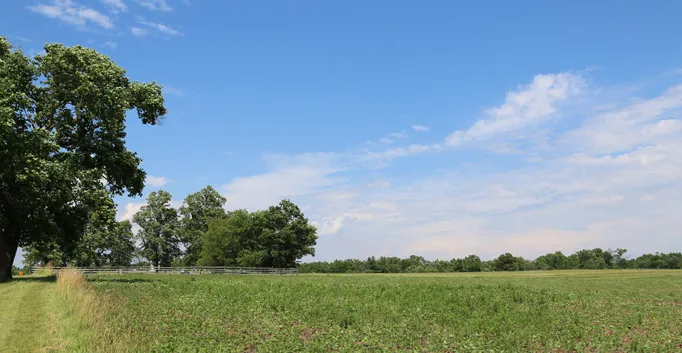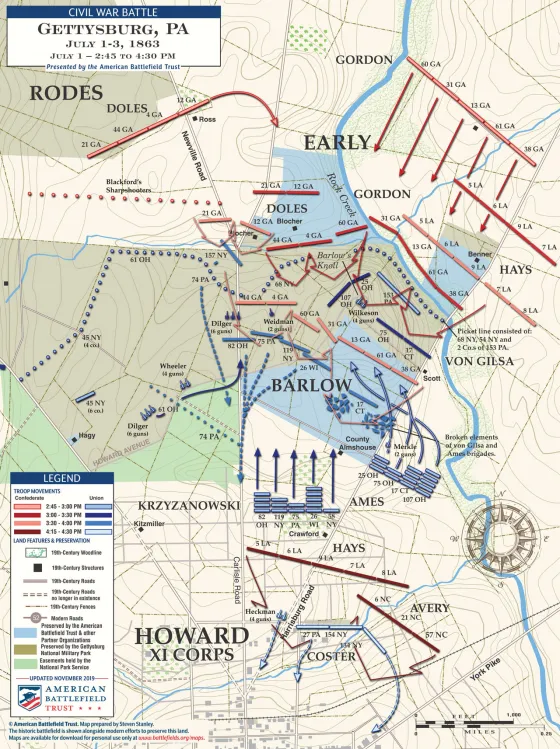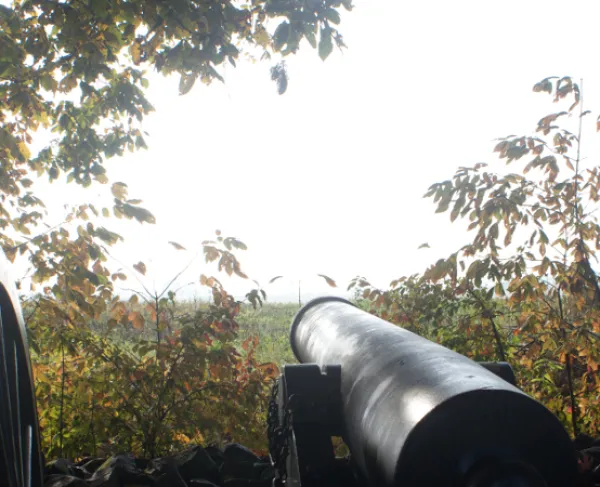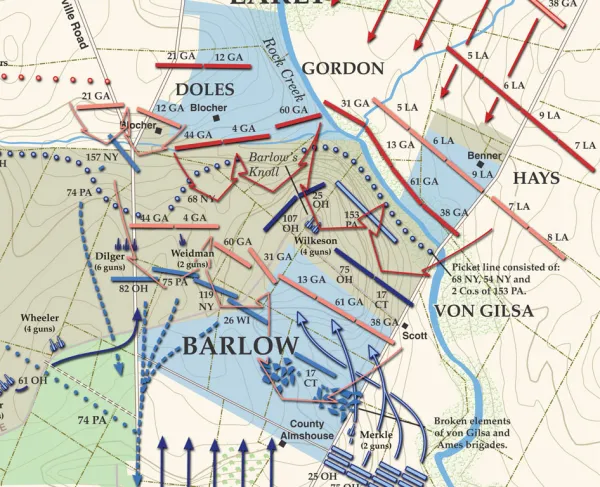To Mark Battle’s 157th Anniversary, American Battlefield Trust Transfers 35-Acre Barlow’s Knoll Property to Gettysburg National Military Park
Gettysburg, PA — Many of the events and activities that are typically scheduled to mark the anniversary of the Battle of Gettysburg have gone digital in 2020, but there is at least one tangible and permanent legacy of the commemoration, as the American Battlefield Trust marks the occasion by transferring a critical 35-acre tract at Barlow’s Knoll to the National Park Service. Protection of this land had been a top park priority for decades when in 2016, the Trust had the opportunity to acquire it from Adams County.
“Among the dozens of battlefield properties that we protect each year, a small number rise above the rest because of their iconic nature,” said Trust President Jim Lighthizer. “Barlow’s Knoll at Gettysburg is certainly in that category. For years and decades to come our members will be able to walk this land and tell their children and grandchildren that ‘I helped do something special by saving this forever.’”

During the fighting on July 1, 1863, the area that became known as Barlow’s Knoll was the far right of the Federal line. This sector of the battlefield was commanded by Brig. Gen. Francis Barlow, whom celebrated historian Bruce Catton described as a “slim, clean-shaven young New York lawyer who had gone into the war as a militia private, and now commanded a division.” Barlow’s two brigades initially deployed in the fields before he made a controversial decision to advance them across the land protected by the Trust and now transferred to the Park, and onto a small rise about 700 yards distant. Barlow had hoped that the elevation would provide an advantage to his artillery, but he overextended his force and was dislodged from the position.
Retreating toward the Adams County Almshouse, again across the Trust-purchased property, Barlow attempted to rally his men, but was badly wounded. On the ground as the battle continued around him, Barlow’s location was overrun by Confederates. Although the popular tale that he was offered assistance by Gen. John B. Gordon is apocryphal, at least one Southern officer did tend to Barlow, likely on the transferred property.
“Gettysburg National Military Park and the American Battlefield Trust have a long and successful history of partnership,” said Park Superintendent Steven Sims. “They are a constant ally and aid in our work, with this land transfer at Barlow’s Knoll being just the latest example. I look forward to many more instances of cooperative preservation”
Because the Barlow’s Knoll tract was entirely within the National Park’s boundary, it was ineligible for federal matching grants designed to create public-private partnerships for battlefield preservation. This meant that the Trust had to raise the full $400,0000 purchase price in private donations. But members quickly answered to the call, responding to the land’s tremendous interpretive value, which National Park Service Chief Historian Emeritus Ed Bearss summarized eloquently: “To me, this property is as important to understanding the first day at Gettysburg as Sickles’ position in the Peach Orchard is on the second day of the battle.”

Seeking the permanent preservation of the land was a meaningful decision according to County Commissioner Randy Phiel. “Adams County's heritage has two significant qualities that stand out —. our history and our agricultural traditions,” he said. “When Adams County sold this tract of land bordering Barlow's Knoll in 2017 to the American Battlefield Trust, the Board of Commissioners ensured that both of these qualities would be preserved for future generations in perpetuity on this historic tract. The National Park Service is an appropriate steward of this land preserving our Adams County and national history; while allowing agricultural practices to continue in the best tradition of Adams County.”
The Battle of Gettysburg was the bloodiest engagement of the Civil War and widely considered a turning point of the conflict. In the summer of 1863, Confederate Gen. Robert E. Lee launched his second invasion of the Northern states. Lee sought to capitalize on recent Confederate victories and defeat the Union army on Northern soil, which he hoped would force the Lincoln administration to negotiate for peace. Lee also sought to take the war out of the ravaged Virginia farmland and gather supplies for his Army of Northern Virginia. But after three days of intense fighting, culminating in the massive frontal assault known as Pickett’s Charge on July 3, and 51,000 combined casualties, Lee’s second invasion of the North collapsed in failure. Four months later, President Abraham Lincoln came to Pennsylvania to participate in the dedication of a cemetery for those killed in the battle, delivering his famed Gettysburg Address during the ceremony.
Today, Gettysburg National Military Park protects more than 6,000 acres of that battlefield and welcomes 1 million visitors annually. The American Battlefield Trust has preserved a total of 1,183 acres at Gettysburg, much of it subsequently transferred into the national park for permanent stewardship and interpretation. The Trust’s highest profile effort at Gettysburg has been the purchase and restoration of the site that served as Lee’s Headquarters during the battle, multimillion dollar project that included removing a hotel complex and subsequently returning the landscape to its wartime appearance.
The American Battlefield Trust is dedicated to preserving America’s hallowed battlegrounds and educating the public about what happened there and why it matters today. The nonprofit, nonpartisan organization has protected more than 52,000 acres associated with the Revolutionary War, War of 1812, and Civil War — including 1,183 acres at Gettysburg. Learn more at www.battlefields.org.





